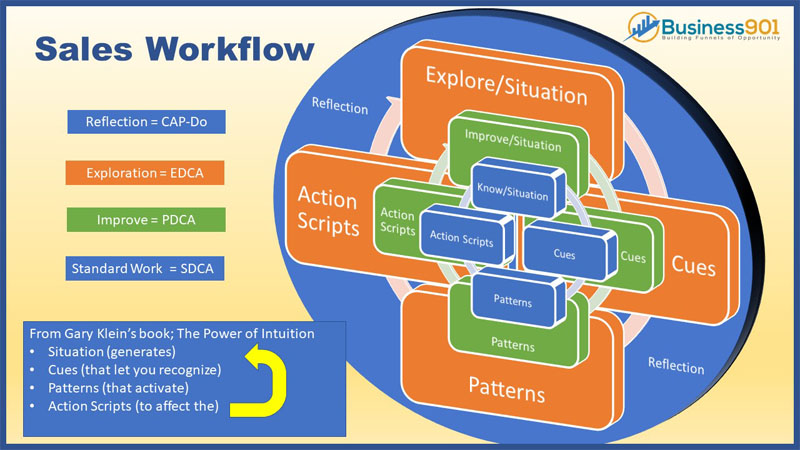Many people/organizations struggle in creating a sales workflow. It is usually to confining or on the opposite end nonexistent. In my thinking, Standard Work is what creates the WOW in the sales process. However, Standards are the most fundamental and misunderstood concept. Your standards are the way you go about what you do and how you do it. It is what your customer understands and experiences. When an employee steps out of the box to do something remarkable, it is a result of having the clarification that this is what our standards (values) would encourage us to do.
A sales workflow/process should empower salespeople to think intuitively and act creatively. Though I use Lean Thinking in my description, (You can learn more about this on my website under The Simplicity of Lean, https://business901.com/the-simplicity-of-lean/, it can be applied using other disciplines. The key to using the Lean Cycles of Cap-Do, EDCA, PDCA, and SDCA, is that is what empowers the salesperson. It is the idea that they do what they know and when they move from their comfort zone they pull the andon, or as a non-Lean person would call it, seek help. This is how we traverse through the cycles. We do, we ask, we learn, we do more. As this process takes place, our understanding and clarification grow. We continuously improve, explore and reflect.
What Klein discusses is that the action script actually has a deeper component which we use to assess our action through a mental simulation or painting a scenario of a process from an existing mental model. In simpler terms, we develop from past experiences a sense of what to do. This is the essence of standard work in my mind.
A sales process is seldom deterministic. Sales lives not only in a complex world but often it is even chaotic. What we need to do I strengthen the idea of intuition into the sales iterations. One of the most difficult things to teach people is intuition. Even when you say, “How to become more intuitive?” it seems to have this mystical sound to it. In Gary Klein’s book, The Power of Intuition (https://amzn.to/2E0SnnP), he discusses the ability to recognize patterns as an integral part of intuition. He says,
Once we recognize a pattern, we gain a sense of a situation. We know what cues are going to be important and need to be monitored. We know what types of goals we should be able to be accomplished. We have a sense of what to expect next. And the patterns include routines for responding — action scripts. If we see a situation as typical, then we can recognize the typical ways to react. That’s how we have hunches about what is really going on, and what we should do about it.
Intuition is the way we translate our experiences into judgments and decisions. It’s the ability to make decisions by using patterns to recognize what’s going on in a situation and to recognize the typical action script with which to react. Once experienced intuitive decision makers see the pattern, any decision they have to make is obvious.
As Klein points out, it is through action and developing a variety of action scripts to pull from the more intuitive you become. I liken it very much to the Lean Cycles. We Know what to do – SDCA or we choose to improve – PDCA, or we choose to explore – EDCA. Using this outline, it becomes an easy process of a situation analysis and collecting the tasks into the appropriate block to create standard work.
An easy way to create a sales workflow is to reverse the process and walk through it backward. What actions did you take? What patterns did you see to activate those actions? What cues did you recognize to form that pattern or make that assumption? What was the situation st that time? You could also create a gap by starting with the present state (situation) and moving back to the past state (situation).
Using Klein’s Intuitive outline allows us to frame our sales standard work in a meaningful way.

